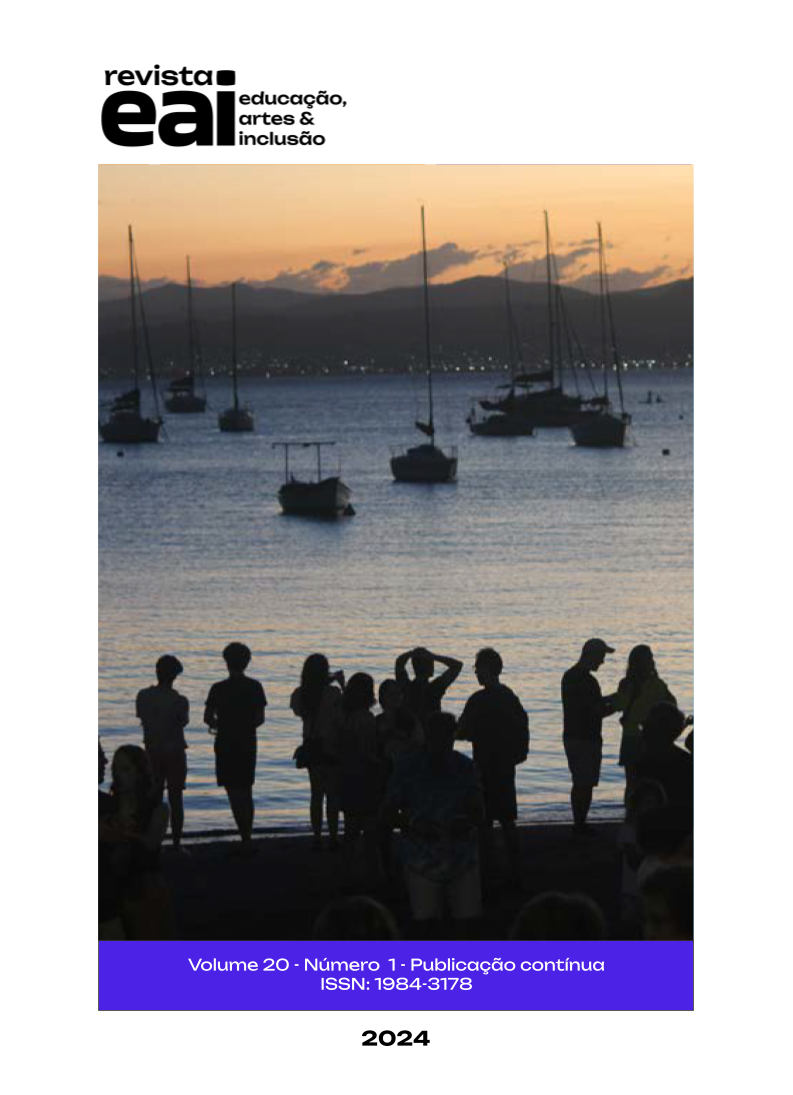Fotografia, ensino e inclusão: Relato de experiência com alunos com deficiência visual
DOI:
https://doi.org/10.5965/198431782012024e0059Palabras clave:
fotografia, paisagem sonora, deficiência visual, acessibilidadeResumen
É aparentemente um contrassenso ponderar a construção de imagens para pessoas com deficiência visual, sobretudo quando tais sujeitos são os autores da produção imagética. De encontro a esta ideia, apresentamos alguns resultados do Projeto de extensão universitária A Fotografia e o Sentir. As ações envolveram o ensino e a prática fotográfica junto aos alunos do IEACN - Instituto de Educação e Assistência aos Cegos do Nordeste, localizado na cidade de Campina Grande - PB. O estudo propõe um debate sobre recursos didáticos e métodos com foco na acessibilidade e inclusão, o uso da multissensorialidade para a construção imagética ao explorar estímulos auditivos e táteis, assim como a importância de propiciar ao aluno com deficiência visual o papel de fonte emissora e criativa. Tomamos por objetivo incentivar sujeitos autônomos e construtores do próprio conhecimento. Para tanto, apresentamos o relato de experiência sobre o desenvolvimento da autonomia e percepção fotográfica dos alunos com deficiência visual, que ao produzirem imagens, estimularam a consciência corporal e exploraram suas percepções, indicando o processo como possível abordagem metodológica para a técnica fotográfica inclusiva. O percurso teórico envolveu Barbosa (1999, 2007), Vygotsky (1997), Schafer (2003), Merleau-Ponty (1994), Alves (2009) entre outros.
Descargas
Citas
ALVES, Jefferson Fernandes. O olhar pelo tato e pela voz: não vidência, fotografia e prática docente. Educação em Questão, v. 27, n. 13, 2006
_____.. Deficiência visual e fotografia: o olhar pelo som, pelo tato e pela palavra alheia. In: CONGRESSO BRASILEIRO MULTIDISCIPLINAR DE EDUCAÇÃO ESPECIAL, 5., 2009, Londrina. Anais [...]. Londrina: Uel, 2009. p. 1127-1134.
BAVCAR, Evgen. O ponto zero da fotografia. VSA art do Brasil, 2000. Disponível em: <https://dobrasvisuais.files.wordpress.com/2010/08/a-luz-e-o-cego.pdf>. Acesso: 18 dez 2020.
D´AVILA, Renato. Teco Barbero revela mistérios da fotografia cega. Novo olhar, G1-Sergipe, 2017. Disponível em: <http://g1.globo.com/se/sergipe/blog/novo-olhar/post/teco-barbero-revela-misterios-da-fotografia-cega.html>. Acesso em: 10. fev. 2021.
DIDI-HUBERMAN, Georges. O que vemos, o que nos olha. 2. ed. São Paulo: 34, 2010.
DONDIS, A. Donis. Sintaxe da linguagem visual. São Paulo: Martins Fontes, 2007.
DUARTE JUNIOR, João Francisco. Por que arte-educação? 6. ed. Campinas: Papirus, 2012.
DUBOIS, Philippe. O ato fotográfico e outros ensaios. Campinas: Papirus, 2012.
FOULKES, Benjamin Mayer. Más allá de la mirada. Disponível em: . Acesso em: 10. dez. 2020.
FLUSSER, Vilém. Filosofia da caixa preta: ensaios para uma futura filosofia da fotografia. São Paulo: Annablume, 2011.
JANELA da Alma. Direção de Direção de João Jardim e Walter Carvalho. São Paulo: Dueto Filmes, 2001. (73 min.), DVD, son., color.
KOSMINSKY, D. Visualidade e visualização: olhar, imagem e subjetividade. In: SZANIECKI, B. et. al. Dispositivo fotografia e contemporaneidade. Rio de Janeiro: NAU, 2013.
MAIA, João. Conheça João Maia, o fotógrafo cego, 2017. Disponível em: <https://college.canon.com.br/blog/conheca-joao-maia-o-fotografo-cego-56>. Acesso em: 10. dez. 2019.
MERLEAU-PONTY, Maurice. Fenomenologia da percepção. São Paulo: Martins Fontes, 1994.
NUNES, Sylvia; LOMÔNACO, José Fernando Bitencourt. O aluno cego: preconceitos e potencialidade. Psicologia Escolar e Educacional, São Paulo, v. 14, n. 1, p. 55-64, jun. 2010. Semestral.
OLIVEIRA, João Ganzarolli. Do essencial invisível: arte e beleza entre os cegos. Rio de Janeiro: Revan Faperj, 2002.
IBGE. Censo Demográfico 2010: características gerais da população, religião e pessoas com deficiência. Rio de Janeiro, 2010. Disponível em: <https://www.ibge.gov.br/estatisticas/sociais/populacao/9662-censo-demografico-2010.html?edicao=9749&t=destaques >. Acesso em: 18. jan. 2020.
RATTON, Miguel B. Fundamentos de áudio. 2 ed. Rio de Janeiro: Music Center, 2007.
RODRIGUEZ, Ángel. A dimensão sonora da linguagem audiovisual. São Paulo: SENAC São Paulo, 2006.
SCHAEFFER, Pierre. Ensaio sobre o rádio e o cinema: estética e técnica das artes-relé 1941-1942. Belo Horizonte: UFMG, 2010.
SCHAEFFER, Pierre. Tratados de los objetos musicales. Madrid: Alianza, 1988.
SCHAFER, R. Murray. O ouvido pensante. São Paulo: UNESP, 2003.
VYGOTSKI, Lev. S. Fundamientos da defctologia: obras escogidas V. Madrid: Visor, 1997.
Descargas
Publicado
Cómo citar
Número
Sección
Licencia
Derechos de autor 2024 Ian Costa, Cristianne Melo

Esta obra está bajo una licencia internacional Creative Commons Atribución-NoComercial 4.0.
Declaración de Derecho de Autor
Los autores que publican en esta revista concuerdan con los siguientes términos:
(A) Autores mantiene los derechos de autor y concede a la revista el derecho de primera publicación, con el trabajo simultáneamente licenciado bajo la Licencia Creative Commons Attribution que permite el compartir el trabajo con reconocimiento de la autoría y publicación inicial en esta revista.
(B) Autores tienen autorización para asumir contratos adicionales por separado, para distribución no exclusiva de la versión del trabajo publicada en esta revista (por ejemplo, publicar en repositorio institucional o como capítulo de libro), con reconocimiento de autoría y publicación inicial en esta revista.
(C) Esta revista proporciona acceso público a todo su contenido, ya que esto permite una mayor visibilidad y alcance de los artículos y reseñas publicadas. Para obtener más información acerca de este enfoque, visite el Public Knowledge Project.
Esta revista tiene una licencia Creative Commons Attribution-NonCommercial 4.0 International. Esta licencia permite que otros remezclen, modifiquen y desarrollen su trabajo con fines no comerciales, y aunque los trabajos nuevos deben acreditarlo y no pueden usarse comercialmente, los usuarios no están obligados a licenciar estos trabajos derivados bajo los mismos términos.





